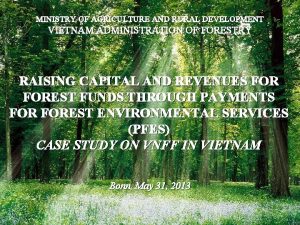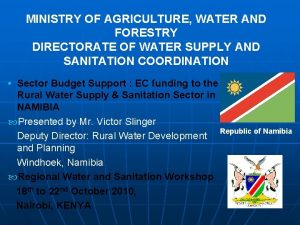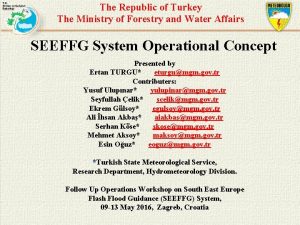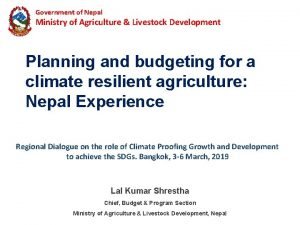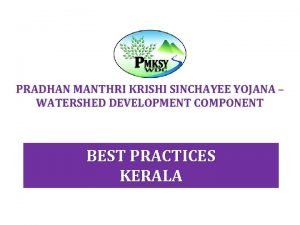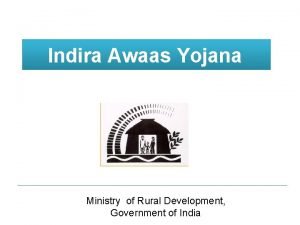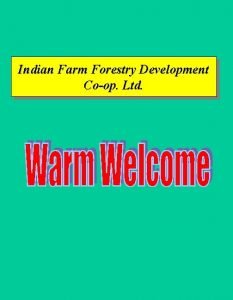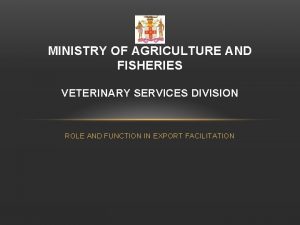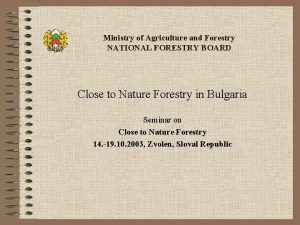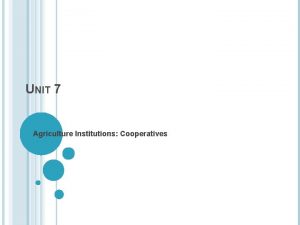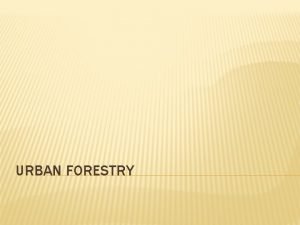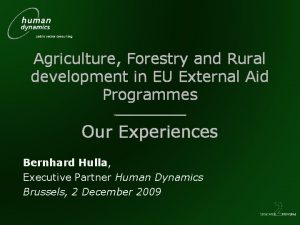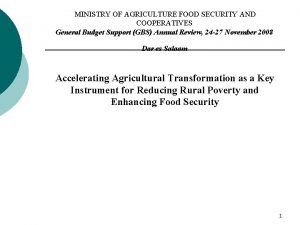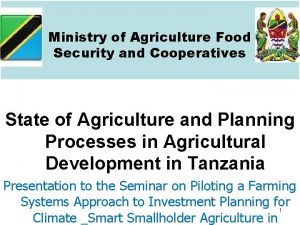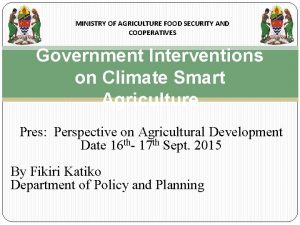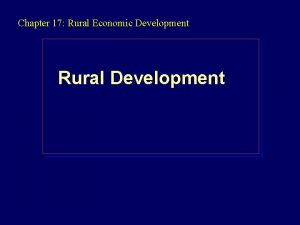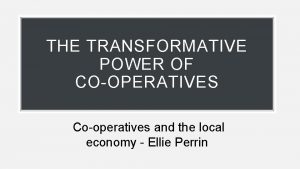Ministry of Agriculture Forestry Cooperatives and Rural Development











- Slides: 11

Ministry of Agriculture, Forestry, Cooperatives and Rural Development Republic of South Sudan Agricultural Transformation in South Sudan Effort for Agricultural Transformation (EAT) Pre-Read for February 5 th, 2013 Ministry of Agriculture and Forestry, Juba

The People and the President of South Sudan have demanded a “hunger-free” nation What will it mean to be “hunger-free”? Ø National food independence Ø Improved health and nutrition across the country Ø Agriculture as a major economic engine, complementing oil and gas Ø Increased incomes for >80% of the population Republic of South Sudan |1

To achieve this goal we will use a zonal approach – building on the unique agricultural potential of each of South Sudan’s agronomic zones What is an integrated zonal transformation? A strategy to develop a targeted zone of the country, focusing on specific crops —with a broad plan providing clear direction across different sectors Plans will be comprehensive: Locations: Tailored to each zone to prioritize scarce resources Crop(s): Focused on select high value crops Change agents: Identify key actors that can drive change Enabling environment: Detailed plans for nonagricultural support And will require us to work together: National and State governments Private sector entrepreneurs Donors and implementing partners Communities and farmers Republic of South Sudan |2

To start the zonal EAT process, opportunities in each agro-ecological zone across South Sudan are being examined The 6 Agro-Ecological Zones of South Sudan 1 6 Western Flood Plains 2 Nile Sobat 3 A Eastern Flood Plains - North 3 B Eastern Flood Plains - South Ironstone Plateau 5 Greenbelt 4 Hills and Mountains Republic of South Sudan |3

c nomi Agro ility b suita n Juba ral fit Cultu est Harv et Mark ial t poten uctio Prod LES ion P EXAM s Exten le Resa Post- t s harve ss ivene mpet r roads et co Mark ed by poo r hinde farm rs Othe : e c Finan Step 4 Choose model(s) of change to address these constraints Wau Yambio-Tambura Block Step 3 Identify key constraints to growth in the valuechain FBO Step 2 Select accessible output markets to link production ly Step 1 Identify a high-potential economic opportunity supp Agro reneur p entre by driven ts ields u Low y uality inp q poor Input The teams followed 4 steps to identify each zone’s economic transformation opportunity 4 Republic of South Sudan |

Steps 1 and 2 identified high-potential economic opportunities in each PRELIMINARY zone which will need to be tested in the coming months Primary opportunity 1 Western Flood Plains 2 Nile Sobat Livestock Rice Sorghum 6 Ironstone Plateau 3 A Eastern Flood Plains - North Simsim Fish Maize Sugar Sorghum 3 B Eastern Flood Plains - South Livestock Sorghum Groundnut Cassava 5 Greenbelt Sorghum Fish 4 Hills and Mountains Irish potatoes Horticulture Maize Simsim Sorghum Horticulture Wheat Emerging opportunities include: ▪ Arid zone – sheep ▪ Greenbelt – small ruminants, aquaculture, honey Republic of South Sudan |5

Steps 3 and 4 looked at the major value chain constraints in each PRELIMINARY opportunity, and identified a primary approach to drive change 1 Western Flood Plains Inclusive irrigation scheme 2 Nile Sobat 3 A Commercial Processing hub 6 Ironstone Plateau Processing Hubs 5 Greenbelt Smallholder aggregation SOURCE: WFP/FAO Crop Assessment; Expert interviews with Ministries of Agriculture and Animal Resources Eastern Flood Plains - North Large-scale commercial farms 3 B Eastern Flood Plains - South Stability promotion through youth engagement 4 Hills and Mountains Trader-lead outgrower scheme Republic of South Sudan | 6

Unlocking these opportunities depends on a strong enabling environment, achieved by deep coordination across Ministries, States, donors, and other stakeholders We will work together … ▪ Ministry of Animal Resources and Fisheries ▪ Ministry of Roads and Bridges ▪ Lands Commission ▪ Ministry of Commerce and Trade ▪ Ministry of Finance ▪ Ministry of Gender ▪ Ministry of Health ▪ Ministry of Environment ▪ State governments ▪ Private sector ▪ Strategic planning support (e. g. , CAMP, FAO) ▪ Donors and development partners ▪ Etc. Roads to connect farmers to markets ▪ ▪ Priority trunk and feeder road rehabilitation Ongoing maintenance Financial assistance to farmers and agro dealers ▪ ▪ ▪ Supportive policies to promote trade ▪ ▪ Consistent interstate tariffs Protection against counterfeit products Access to credit for inputs Capital loans for machinery Support for imports Social improvements to empower farmers ▪ ▪ Health and nutrition investments Empowering female farmers and cooperatives SOURCE: Expert interviews with Ministries of Agriculture and Finance; Workshop discussions in Torit, Magwi, Yambio and Republic of South Sudan Yei counties | 7

Each zone is being assessed on several factors important for rapid growth Existing Infrastruc ture ▪ ▪ 1 Western Flood Plains 2 Nile Sobat 3 a Eastern Flood Plains – North 3 b Eastern Flood Plains – South 4 Hills and Mountains 5 Greenbelt 6 Ironstone Plateau Security status Length of time to impact Return Funding on inavailable 1 vestment Legend: Good Medium Difficult Overall Readiness All zones have clear potential but each transformation requires its own locally-specific strategy We will learn from our initial efforts and apply lessons to each subsequent zone 1 RSS and donor SOURCE: IFPRI Statistical yearbook (2010), World Bank “Agricultural Potential” (2012) Republic of South Sudan |

In order to refine these hypotheses, we have planned a full-day meeting to review our findings in detail and plan the critical next steps Timing Description Facilitator Introduction 10 -10: 15 Opening remarks H. E. Vice President 10: 15 -10: 30 Introduction H. E. Min of Ag § Reminder: Why zonal approach? (Focus, unified investment plan across RSS & donors) § 3 phases of the transformation Zonal overviews 10: 30 -11: 00 Presentation: 6 agro-ecological zones H. E. Min of Ag § “Quick win” opportunities § Costs and challenges 11: 00 -12: 00 Working groups: Zonal investment plan feedback EAT working team 12: 00 -12: 30 Prioritization and Next Steps H. E. Min of Ag LUNCH BREAK Deep dive: Greenbelt Illustration 1: 30 -3: 00 -4: 00 Presentation: Greenbelt § Overall goals § Locally targeted strategies H. E. Min of Ag State representatives Enabling Environment: Needs and investments EAT working team Scale-up plans: Operationalizing and scaling to all zones 4: 00 -5: 00 Next steps H. E. Min of Ag Republic of South Sudan |9

Next steps following the meeting: Prioritize and sequence investments based on ROI and feasibility ▪ ▪ ▪ Validate economic opportunity choices for each zone Develop detailed investment plan Understand fiscal resources for both donor and government Design the management structure for the effort ▪ ▪ ▪ Determine the leadership structure and lines of authority Construct monitoring and evaluation plan Set stakeholder milestones and schedule for reconvening Republic of South Sudan | 10
 Ministry of agriculture and rural development cameroon
Ministry of agriculture and rural development cameroon Ecotourim
Ecotourim Ministry of agriculture, water and forestry directorates
Ministry of agriculture, water and forestry directorates Eturgu
Eturgu Ministry of agriculture and livestock development nepal
Ministry of agriculture and livestock development nepal Ministry of rural development
Ministry of rural development Ministry of rural development
Ministry of rural development Mendel university fees
Mendel university fees Maine department of agriculture conservation and forestry
Maine department of agriculture conservation and forestry Ministry of food agriculture and fisheries denmark
Ministry of food agriculture and fisheries denmark Coop
Coop Ministry of agriculture veterinary services
Ministry of agriculture veterinary services

